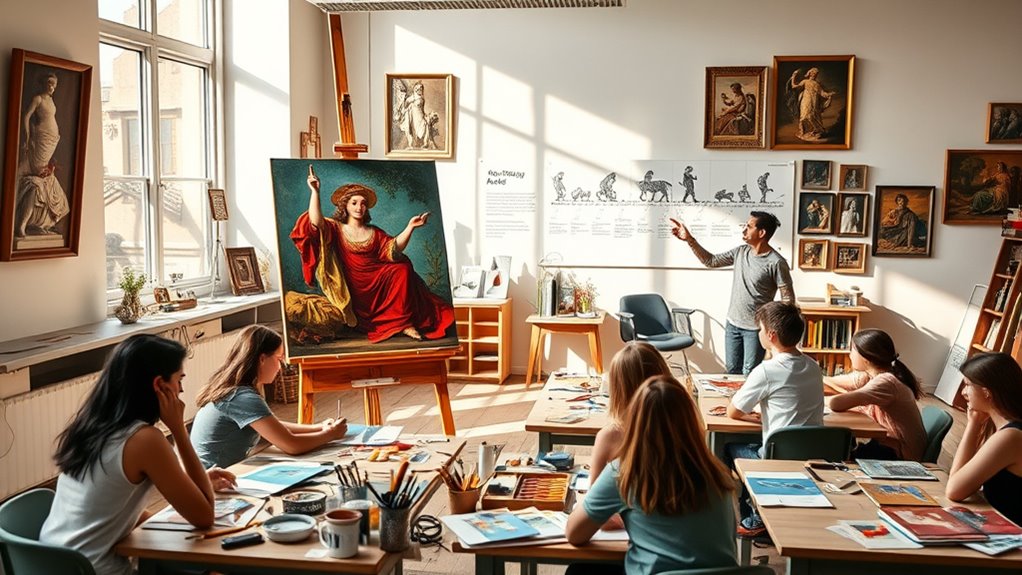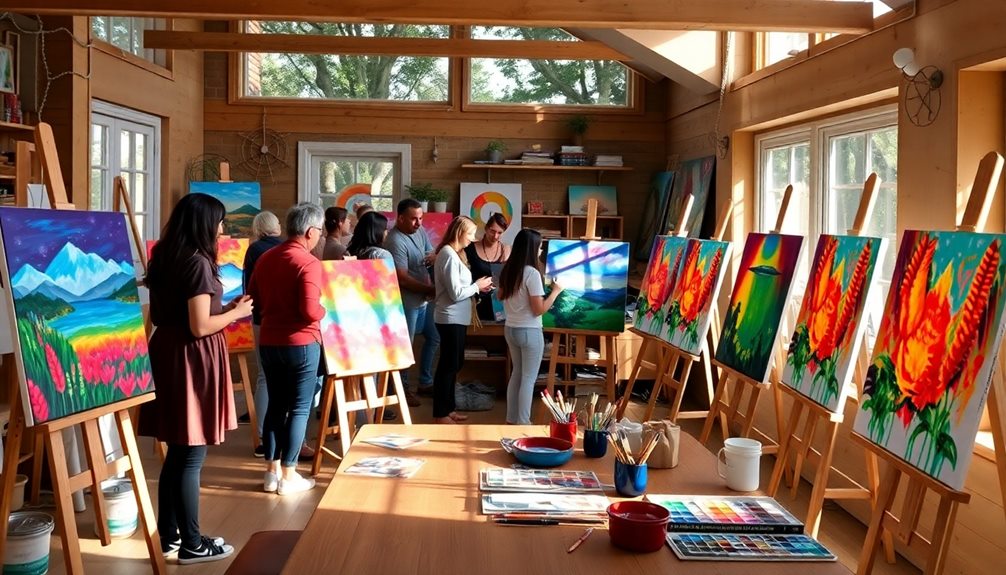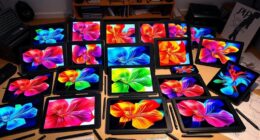To bring art history into your studio, start by exploring how cultural, political, and technological influences shape artistic styles and themes. Use these insights to inspire your work and inform your choices of motifs, techniques, and mediums. By integrating historical context into your creative process, you’ll create more meaningful and authentic pieces. Keep exploring these connections further to deepen your artistic practice and find new sources of inspiration.
Key Takeaways
- Incorporate historical artworks and techniques into studio practice to deepen understanding and foster skill development.
- Use cultural and societal contexts to inform thematic choices and enhance the narrative quality of artworks.
- Encourage exploration of different art movements to inspire innovation and diversify artistic expression.
- Discuss the influence of historical events and societal values on artistic styles to create meaningful pieces.
- Integrate art history lessons with studio projects to promote critical thinking and cultural literacy.

Integrating art history into studio practice enriches your creative process by providing essential context and inspiration. When you connect your work to the broader cultural influences that shaped past artists, you gain a deeper understanding of how societal values, political climates, and technological advancements have influenced artistic evolution. This knowledge allows you to see your own work within a larger narrative, helping you identify themes, techniques, or motifs that resonate across different periods and cultures. By studying how art responded to its environment, you can adopt or challenge those influences, forging a more meaningful and intentional artistic voice.
Understanding cultural influences reveals that art never exists in a vacuum. It’s a reflection of the ideas, beliefs, and tensions of its time. For example, exploring the Renaissance’s emphasis on humanism can inspire you to focus on the human condition in your own work, while examining African tribal art might encourage you to experiment with patterns and symbolism. Recognizing these cultural influences helps you develop a more nuanced approach, blending historical context with your personal perspective. This fusion often results in artwork that communicates more effectively and resonates on a deeper level with viewers.
Incorporating art history also highlights the continuous artistic evolution—how styles, mediums, and themes have transformed over centuries. It’s fascinating to see how Impressionism broke away from traditional realism, or how contemporary digital art pushes boundaries of technology. When you study these shifts, you understand that change is integral to artistic progress. This perspective encourages you to experiment fearlessly, knowing that innovation and adaptation are natural parts of your creative journey. It also helps you appreciate the diversity of artistic expressions, inspiring you to explore unfamiliar styles or techniques with confidence. Additionally, understanding artistic techniques used in different periods can help refine your own skill set and approach. Recognizing the evolution of art styles can further motivate you to develop a unique voice that is informed by history yet personally authentic. Moreover, understanding artistic influences can help you identify the sources of inspiration that resonate most with your personal style.
Frequently Asked Questions
How Can I Adapt Art History for Different Age Groups?
You can adapt art history for different age groups by using age-appropriate strategies and engaging learning methods. For younger students, incorporate storytelling and visual aids to make concepts relatable. Older students benefit from critical discussions and hands-on projects that connect history to contemporary issues. Adjust complexity based on age, ensuring activities are interactive and relevant, so each group stays interested and motivated to explore art’s historical context.
What Are Effective Ways to Assess Understanding of Art Context?
Like a detective seeking clues, you can use assessment strategies to gauge students’ understanding of art context. Ask open-ended questions that require them to connect artwork with its historical background. Use visual analysis tasks or creative projects that demonstrate contextual comprehension. Observation and discussions also reveal their grasp of the story behind the art. These methods help you see if they’ve truly internalized the cultural and historical layers, much like uncovering hidden meaning.
How Do I Incorporate Digital Resources Into Lessons?
To incorporate digital resources into your lessons, you can use interactive timelines to help students explore art history chronologically, making connections clearer. Virtual museum tours give students immersive experiences without leaving the classroom, bringing artwork and context to life. Encourage students to analyze pieces they view online, fostering engagement and understanding. These tools make art history more accessible and dynamic, helping students connect concepts with visual and contextual details effectively.
What Challenges Might Arise When Combining Art History and Studio Work?
Imagine a delicate dance where painting and history intertwine. When you combine art history with studio work, you might struggle to balance curriculum demands while keeping student engagement high. Students could feel overwhelmed by the wealth of information or distracted from hands-on creation. Managing these challenges requires careful planning so that history enriches rather than complicates, ensuring both educational depth and creative enthusiasm flourish side by side.
How Can I Encourage Students to Reflect on Historical Influences Creatively?
To encourage your students to reflect on historical influences creatively, give them engaging prompts that connect art history to their personal experiences. Use reflective exercises that ask them to analyze how past artists’ techniques or themes inspire their own work. Challenge them to reinterpret historical styles through modern lenses, fostering deeper understanding and innovation. These strategies help students see history as a living, evolving part of their creative process.
Conclusion
By weaving art history into your studio lessons, you truly breathe new life into your students’ creativity. It’s like hitting two birds with one stone—fostering technical skills while deepening their understanding of cultural context. Remember, knowledge is power, and when students see the bigger picture, their work gains meaning and depth. Keep this approach in mind, and you’ll find that art and history together can open doors you never knew existed.









